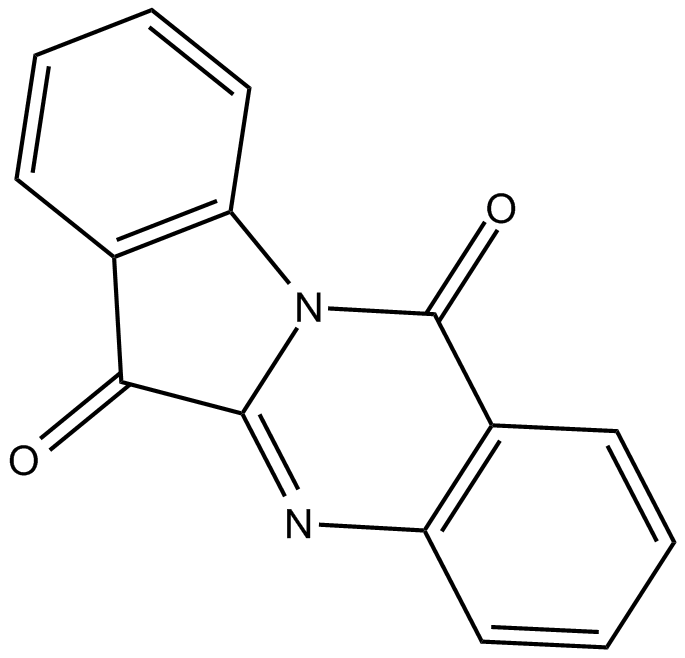Tryptanthrin (Synonyms: NSC 349447) |
| Katalog-Nr.GC13402 |
Tryptanthrin ist ein Indolchinazolin, das ein Alkaloid aus indigohaltigen Pflanzen sein kÖnnte.
Products are for research use only. Not for human use. We do not sell to patients.

Cas No.: 13220-57-0
Sample solution is provided at 25 µL, 10mM.
Tryptanthrin, a weakly basic alkaloid tryptophan derivative originally isolated from the dried roots of medicinal indigo plants, has anti-inflammatory and anticancer activities. And, tryptanthrin blocks 5-lipoxygenase (5-LO) and cyclooxygenase-2 (Cox-2) with IC50 values of 600 and 64 nM, respectively.
5-LO and Cox-2 are involved in cancer pathobiology. 5-LO is expressed by a variety of cancer cells including colon, lung, breast, and prostate and promotes cancer cell growth and neo-angiogenesis. Cox-2, overexpressed in cancer cells, promotes tumorigenesis and induces neo-angiogenesis.
In vitro: In human hepatocyte-derived HepG2 cells, tryptanthrin inhibited the reactive oxygen species formation, mitochondrial dysfunction, and cell death triggered by tert-butyl hydroperoxide (tBHP). Furthermore, tryptanthrin reversed the reduction of glutathione (GSH) induced by tBHP. Specifically, nuclear translocation, transactivation of nuclear factor erythroid 2-related factor 2 (Nrf2), and phosphorylation of extracellular signal-regulated kinase (ERK) were evoked by the treatment of tryptanthrin. Additionally, the expression of the heme oxygenase 1 and glutamate was upregulated by tryptanthrin [1].
In vivo: BALB/c (H-2d) mice, intraperitoneally (i.p.) inoculated with leukemia WEHI-3B JCS cells, were injected i.p with tryptanthrin at doses of 0.04 mg/kg, 0.08 mg/kg and 0.16 mg/kg body weight for 5 consecutive days. Tryptanthrin inhibited the growth of WEHI-3B JCS cells in BALB/c mice, and at the dosages of 0.08 mg/kg and 0.16 mg/kg, significant inhibition was seen. Moreover, tryptanthrin, in a dose-dependent fashion, triggered cell cycle arrest of the WEHI-3B JCS cells at G0/G1 phase [2].
References:
[1]. Moon, S., Lee, J., Choi, H., Cho, I., Kim, S., & Kim, Y. Tryptanthrin Protects Hepatocytes against Oxidative Stress via Activation of the Extracellular Signal-Regulated Kinase/NF-E2-Related Factor 2 Pathway. Biological and Pharmaceutical Bulletin. 2014; 37(10): 1633-1640.
[2]. Chan, H., Yip, H., Mak, N., & Leung, K. Modulatory Effects and Action Mechanisms of Tryptanthrin on Murine Myeloid Leukemia Cells. Cellular and Molecular Immunology. 2009; 6(5): 335-342.
Average Rating: 5 (Based on Reviews and 39 reference(s) in Google Scholar.)
GLPBIO products are for RESEARCH USE ONLY. Please make sure your review or question is research based.
Required fields are marked with *




















